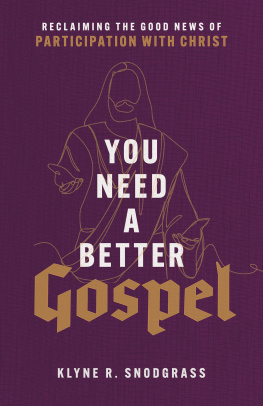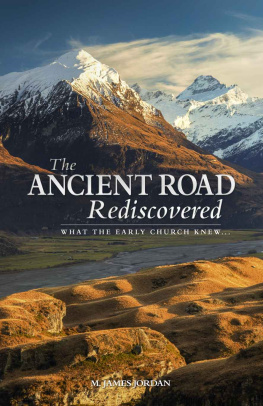Heilbut - The gospel sound : good news and bad times
Here you can read online Heilbut - The gospel sound : good news and bad times full text of the book (entire story) in english for free. Download pdf and epub, get meaning, cover and reviews about this ebook. year: 1985, publisher: New York : Limelight Editions ; Distributed by Harper & Row, genre: Detective and thriller. Description of the work, (preface) as well as reviews are available. Best literature library LitArk.com created for fans of good reading and offers a wide selection of genres:
Romance novel
Science fiction
Adventure
Detective
Science
History
Home and family
Prose
Art
Politics
Computer
Non-fiction
Religion
Business
Children
Humor
Choose a favorite category and find really read worthwhile books. Enjoy immersion in the world of imagination, feel the emotions of the characters or learn something new for yourself, make an fascinating discovery.
- Book:The gospel sound : good news and bad times
- Author:
- Publisher:New York : Limelight Editions ; Distributed by Harper & Row
- Genre:
- Year:1985
- Rating:3 / 5
- Favourites:Add to favourites
- Your mark:
- 60
- 1
- 2
- 3
- 4
- 5
The gospel sound : good news and bad times: summary, description and annotation
We offer to read an annotation, description, summary or preface (depends on what the author of the book "The gospel sound : good news and bad times" wrote himself). If you haven't found the necessary information about the book — write in the comments, we will try to find it.
Heilbut: author's other books
Who wrote The gospel sound : good news and bad times? Find out the surname, the name of the author of the book and a list of all author's works by series.
The gospel sound : good news and bad times — read online for free the complete book (whole text) full work
Below is the text of the book, divided by pages. System saving the place of the last page read, allows you to conveniently read the book "The gospel sound : good news and bad times" online for free, without having to search again every time where you left off. Put a bookmark, and you can go to the page where you finished reading at any time.
Font size:
Interval:
Bookmark:

Heilbut, Anthony
This book was produced in EPUB format by the Internet Archive.
The book pages were scanned and converted to EPUB format automatically. This process relies on optical character recognition, and is somewhat susceptible to errors. The book may not offer the correct reading sequence, and there may be weird characters, non-words, and incorrect guesses at structure. Some page numbers and headers or footers may remain from the scanned page. The process which identifies images might have found stray marks on the page which are not actually images from the book. The hidden page numbering which may be available to your ereader corresponds to the numbered pages in the print edition, but is not an exact match; page numbers will increment at the same rate as the corresponding print edition, but we may have started numbering before the print book's visible page numbers. The Internet Archive is working to improve the scanning process and resulting books, but in the meantime, we hope that this book will be useful to you.
The Internet Archive was founded in 1996 to build an Internet library and to promote universal access to all knowledge. The Archive's purposes include offering permanent access for researchers, historians, scholars, people with disabilities, and the general public to historical collections that exist in digital format. The Internet Archive includes texts, audio, moving images, and software as well as archived web pages, and provides specialized services for information access for the blind and other persons with disabilities.
Created with abbyy2epub (v.1.7.0)
GOSPELSOIJ9ID
Good News and Bad Times
by Anthony Heilbut
"The definitive popular history of the mostoverlooked American music."
Jon Landau, Rolling Stone
OURPBiCE
Revisedand Updated
THE GOSPEL SOUND
CONTENTS
Preface vii
Introduction: The Gospel Moment ix
Part One: Building the Gospel Highway
1 "Sallie Martin's Outta Sight" 3
2 "I Get These Special Vibrations": Thomas A.
Dorsey 21
3 The Head of the House: Ira Tucker 37
4 Mahalia the Queen 57
5 "The Women Had Fits": The Soul Stirrers 75
Part Two: The Gospel Pioneers
6 Reverend Brewster and the Ward Singers 97
7 Reverend Julius Cheeks and Reverend Claude
Jeter: The Fathers of Soul 115
8 "Bessie Can Moan and Move a Mountain" 131
9 Professor Alex Bradford: "The Singing Rage" 145
10 "I Won't Let Go of My Faith": Dorothy Love
Coates 159
Part Three: The Holiness Church
11 The Holiness Church 173
12 The Traveling Saints 187
Vi CONTENTS
13 The Crown Prince of Gospel: James Cleveland 205
14 "I've Been Way Out on the Stormy Raging
Sea": Marion Williams 221
15 The Young Smgers 237
Part Four: The Gospel Life
16 "You May Never Go to Prison" 255
17 "Turn Your Radio On", 1969 265
18 A Weekend with the Campbells 283Epilogue: "Lx)oked Down the Line and I
Wondered" (1971) 295
Postscript 301
Acknowledgments 333
DiSCOGRAPHY 335
Index of Names 355
Index of Song Titles 365
PREFACE
This book first appeared in 1971. At that time, the asser-tion that gospel singing supplied the roots for much of con-temporary music was not widely accepted; today it seemsa received truth. But, paradoxically, though the gospelsound is now universal, the culture that produced it ap-pears increasingly a thing of the past. At its best, theblack gospel church provided the richest form of Americanfolklore. Its language combined the stately periods ofeighteenth-century prose with the richness of southerncountry talk and ghetto slang. More than this, the gospelculture with its rituals, images, and psychological assump-tions allowed generations of untutored artists to expressthemselves in a maimer as free and improvisatory as theycared to make it. Virtually alone among popular forms offolklore, it recognized the importance and creative ca-pacity of women. A cynic may scoff at the gospel churchas matriarchalthough some of gospel's greatest exponentsare malebut the indisputable fact is that in church sing-ing women could be peerless artists, not by denying theirsocial situation, but by drawing upon all its elements as re-sources.
It is to these great folk artists that this book is dedicated,especially the older singers, "the ones who didn't sell out"but stuck with their music despite the encroachments andtemptations of the world. Their "gospel bird" may be anendangered species but it still keeps flying.
Anthony Heilbut1975
The Gospel Moment
In January 1969, 50,000 black Chicagoans troopedthrough Mount Pisgah Baptist Church on the newly namedDr. Martin Luther King Drive. They were viewing the bodyof Roberta Martin, a gospel singer whose obituary did notappear in The New York Times and whose funeral noteven Jet reported. Roberta Martin had grown rich fromher gospel group and publishing studio. But she beganher career in store-front churches, singing for nickels anddimes, and the poor who supported her then gathered nowto pay their final respects. Roberta Martin belonged tothem, to all the impoverished singers who tell you, "We'renot here for form and fashion. We're here to be our-selves." She'd helped give them a way to be themselvesthrough a musical style that could lure the most depressed.While she reigned they rejoiced; now they honored heras someone who'd "stuck with her own." Miss Martin'sorigins and struggles meant a lot more that week than aUher worldly success. And all over America, gospel fans whohad shared vicariously in her route, who could all testify,"My soul looks back and wonders how I got over," cele-brated her for, as they said, opening doors and movingmountains. They mourned as they'd supported, without
benefit of any mass media but their own: radio broadcastsand word of mouth.
Church people like to say, "There's none so blind as hewho will not see." For forty years America has nurturedunacknowledged a cultural form as imposing as jazz, and alife style as peculiarly native as the hippie's. Yet while themass media devour anything new, subverting the avant-garde simply by making it available, an area of Americanlife crucial to millions of people is never gobbled up asnews.
The gospel sound Roberta Martin helped inaugurate iseverywhere. All rock's most resilient features, the beat, thedrama, the group vibrations derive from gospel. From rocksymphonies to detergent commercials, from Aretha Frank-lin's pyrotechnique to the Jacksons' harmonics, gospel hassimply reformed all our listening expectations. The verytension between beats, the climax we anticipate almostsubliminally, is straight out of the church. The dance stepsthat ushered in a new physical freedom were copied fromthe shout, the holy dance of "victory." The sit-ins soothedby hymns, the freedom marches powered by shouts, the"brother and sister" fraternity of revolution: the gospelchurch gave us all these. But if gospel music is obliquelymiportant to Middle America, it's central to any study ofthe black ghetto. The huge turnout for Roberta Martin'sfuneralreportedly the largest ever held in Chicagois asmall sign of gospel's hold on its followers. Consider theghetto store windows cluttered with gospel placards, thecity stadiums packed with gospel fans. One would thinkthese signs alone would clue America that a formidableunderground identifies itself with a unique musical style,especially now that rock has done something similar foran entire generation. But gospel singers and their audi-ences remain the best-kept secret of ghetto culture.
**The world never did love us," they say, "but we're go-ing on anyhow." Along the way they have constructed aworld complete unto itself. Obviously gospel lovers have
Next pageFont size:
Interval:
Bookmark:
Similar books «The gospel sound : good news and bad times»
Look at similar books to The gospel sound : good news and bad times. We have selected literature similar in name and meaning in the hope of providing readers with more options to find new, interesting, not yet read works.
Discussion, reviews of the book The gospel sound : good news and bad times and just readers' own opinions. Leave your comments, write what you think about the work, its meaning or the main characters. Specify what exactly you liked and what you didn't like, and why you think so.










